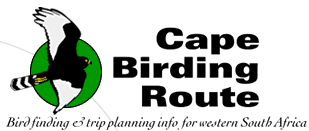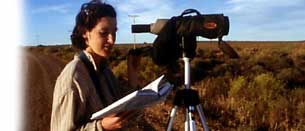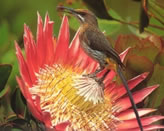Select
Specials: Seabirding
Wandering
Albatross
Few
sights epitomize the freedom of the open oceans as elegantly
as a soaring Wandering Albatross. With the longest wingspan
of any bird (in excess of 3.5 metres in some cases), these
majestic ocean travellers are able to spend many months on
the open sea, effortlessly exploiting updrafts from the waves
to stay aloft.
They
are perhaps most famous for their life-long pair bonding display,
during which the two birds face each other with wings outstretched
and bills pointing skywards. However, this long-lived star
of many nature documentaries is under threat, and it is believed
that up to 10 per cent of the world population may be lost
to longlining each year (p.39). As pairs can only raise, at
most, one chick every two years, and because it will take
11 years before the offspring is ready to breed, urgent steps
must be taken to avert the imminent extinction of this graceful
seafarer.
Spectacled Petrel
The
‘Ringeye’, as it is more affectionately known, was
only recently recognized as a full species, split from White-chinned
Petrel. This taxonomic decision, based largely on the breeding
calls, bestows upon it the dubious distinction of being one
of the world’s most threatened seabirds. Only about 10
000 individuals exist, breeding only on Inaccessible Island
in the South Atlantic Ocean. Alarmingly, it is believed that
as much as 5 per cent of the population is killed annually
by longline fishing off Brazil (p.39). The diagnostic white
facial crescent separates it from White-chinned Petrel only
at close range, and care must thus be taken not to confuse
it with occasional White-chinned Petrels that show white patches
on the head.
Leach’s Storm Petrel
Because
it is regularly seen only far offshore in Cape waters, Leach’s
Storm Petrel was assumed to be an exclusively non-breeding
migrant from the northern hemisphere during our summer months.
However, this species was discovered as recently as 1997 by
Phil Whittington to be breeding on Dyer Island (near Hermanus;
see map, p.58), making it the African continent’s only
breeding pelagic seabird. Up to twenty pairs of birds breed
on the island annually, and can be heard calling at night
from their nesting burrows deep in the old stone walls that
surround the island’s few buildings. The lateness of
this discovery can be attributed to the birds’ strictly
nocturnal activity.
Southern Giant Petrel
Because
it is difficult to distinguish from its sister species, the
Northern Giant Petrel, many giant petrels seen in Cape waters
remain indeterminate. The most useful feature in separating
the two species is the bill tip: in the Southern Giant Petrel
it is a greenish colour, while in the Northern Giant Petrel
it is horn-coloured. Unique to the Southern Giant Petrel is
the rare white phase, in which the whole bird is an ivory
colour. The giant petrels are the vultures of the sea, often
scavenging on dead seals, especially on their breeding grounds.
A century ago, giant petrels used to gather in great numbers
to scavenge at the Cape’s whaling stations.
|


